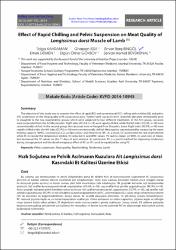Effect of rapid chilling and pelvic suspension on meat quality of longissimus dorsi muscle of lamb

View/
Access
info:eu-repo/semantics/openAccessDate
2014Author
Kahraman, TolgaGhassan, Issa
Bingöl, Enver Barış
Dümen, Emek
Göksoy, Ergün Ömer
Büyükünal, Serkan Kemal
Metadata
Show full item recordCitation
Kahraman, T., Ghassan, I., Bingöl, E. B., Dümen, E., Göksoy, E. Ö., Büyükünal, S. K. (2014). Effect of rapid chilling and pelvic suspension on meat quality of longissimus dorsi muscle of lamb. Kafkas Üniversitesi Veterinerlik Fakülte Dergisi. 20.5, 697-701.Abstract
The objective of this study was to examine the effect of rapid (RC) and conventional (CC) chilling with achilles (AS) and pelvic (PS) suspension on the meat quality of M. Longissimus dorsi. Twenty lamb carcasses were randomly allocated immediately prior to slaughter to the two experimental groups which were subjected to four different treatments. In the first group, carcasses were suspended from the Achilles tendon. Right sides (RC/AS; n=10) were rapidly chilled, while the left sides (CC/AS; n=10) were conventionally chilled. In the second group, the carcasses were re-hanged from the pelvic bone. Right sides (RC/PS; n=10) were rapidly chilled whilst the left sides (CC/PS; n=10) were conventionally chilled. Meat quality was evaluated by measuring the water holding capacity (WHC), cooking loss (CL), surface colour and shear force (SF). As a result, CC accelerated the rate of pH decline while RC increased the temperature decline. RC reduced CL and WHC values. PS had no impact on WHC, CL and color of steaks, but decreased the SF values on the 7th days of post-mortem. In conclusion; PS is a useful method for improving tenderness during storage period and the disadvantageous effect of RC on SF could be equalized by using PS.

















